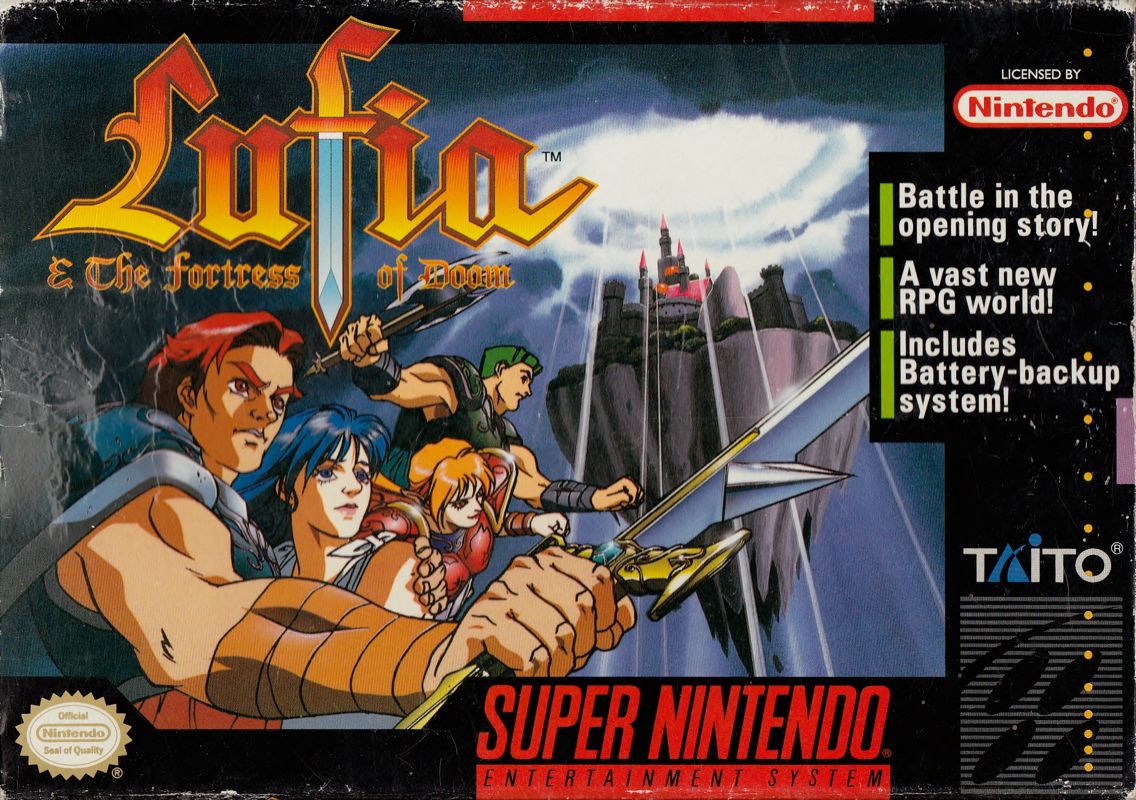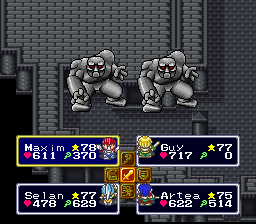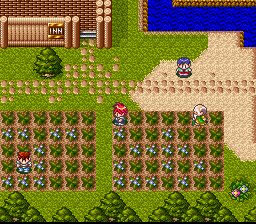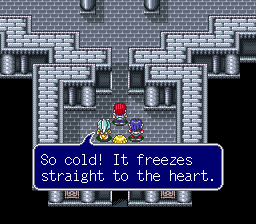Retro Replay Review
Gameplay
Lufia & the Fortress of Doom offers a classic turn-based RPG experience that will feel instantly familiar to veterans of the genre. Combat is menu-driven, with your party selecting physical attacks, magic spells or items from a row of intuitive icons. Random encounters are frequent enough to keep your level curve steady, but not so relentless that they become unbearable. The pacing allows you to savor each battle as you refine strategies, exploit enemy weaknesses and balance offense with support spells.
(HEY YOU!! We hope you enjoy! We try not to run ads. So basically, this is a very expensive hobby running this site. Please consider joining us for updates, forums, and more. Network w/ us to make some cash or friends while retro gaming, and you can win some free retro games for posting. Okay, carry on 👍)
What really sets this title apart is its in-dungeon puzzles. Instead of treating labyrinthine caverns as mere monster farms, Lufia’s designers inject thoughtful challenges at every turn. You’ll push crates, align mirrors to channel light, and navigate pressure-sensitive tiles—often under the pressure of hidden traps or time constraints. These brain-teasers break up the combat rhythm and reward careful observation, making each new dungeon feel like a fresh test of wits.
Between boss fights and puzzle rooms, exploration unfolds atop a charming overworld map. You’ll visit bustling towns, mysterious ruins and seasonal locales, each populated with NPCs eager to share rumors, sidequests or a healing potion. Character progression is straightforward: accumulate experience, learn new skills and fine-tune your inventory. Group dynamics matter too, as each hero brings unique abilities—healers reinforce your front line, mages decimate foes at range and tanks soak up damage. Mastering their synergy is half the fun.
Graphics
For a mid-’90s Super Nintendo title, Lufia & the Fortress of Doom showcases vibrant pixel art that has aged gracefully. The world’s lush forests, icy peaks and crumbling castles are rendered with a bright palette that leaps off the screen. Colorful, hand-drawn map tiles convey a sense of scale and adventure as you traverse mountains, seas and hidden pathways.
Character sprites are well-animated, with each hero displaying distinct idle poses, attack swings and spell-casting flourishes. Enemies range from grotesque skeletons to hulking Stone Giants, and their battle animations—though somewhat limited by hardware—still offer satisfying visual feedback when you land a critical hit or unleash a powerful spell. The subtle screen shakes and flash effects heighten the impact of high-damage moves.
Dungeon interiors and puzzle rooms benefit from clever tile design that separates walkable floors, switch panels and pushable blocks at a glance. Secret doors, hidden alcoves and illusory walls are often indicated by slight color shifts, rewarding players who pay attention to environmental details. While the cutscenes are modest by modern standards, their cinematic framing and expressive portraits help drive the narrative forward.
Story
Set a century after the valiant Maxim triumphed over the Sinistrals, the world basks in peace—and complacency. When new attacks ravage villages, rumors swirl that the dreaded Sinistral gods have returned. You take control of the hero’s descendant alongside his childhood friend, Lufia, as they seek to rally a new band of champions and uncover the dark truth behind the assaults.
The story unfolds at a measured pace, alternating between quiet character moments and epic confrontations. You’ll recruit diverse allies—a hotheaded swordsman, a scholarly mage, a stoic warrior—each bearing personal motivations and backstories. Their in-party banter deepens your engagement, whether they’re trading friendly jabs or debating the morality of using magic to combat divine foes.
As clues emerge, the narrative twists reveal betrayals, hidden lineages and the true mastermind manipulating events behind the scenes. The game balances grand world-saving stakes with intimate moments of sacrifice and loyalty. Though the localization occasionally shows its age in awkward phrasing, the core story remains compelling: it’s a tale of destiny tested, friendships forged and the eternal struggle between mortals and gods.
Overall Experience
Lufia & the Fortress of Doom strikes a gratifying blend of traditional JRPG combat and inventive dungeon puzzles. Its turn-based battles reward tactical planning, while its puzzle-heavy dungeons provide a refreshing change of pace. The world feels alive thanks to colorful art, memorable NPCs and a soundtrack that underscores each environment’s mood.
On the flip side, the frequent random encounters can become a grind for players accustomed to modern encounter systems, and the menu navigation occasionally feels dated. Additionally, there are translation quirks and limited quality-of-life features compared to newer titles. However, these minor issues are outweighed by the title’s craftsmanship and the depth of its dungeons.
Ultimately, Lufia & the Fortress of Doom will resonate most with enthusiasts of retro JRPGs and puzzle aficionados. If you’re seeking a challenging throwback that demands both strategic combat and sharp problem-solving, this classic SNES adventure remains a standout. It’s a journey well worth undertaking for anyone who appreciates heartfelt storytelling wrapped in vibrant, sprite-based charm.
 Retro Replay Retro Replay gaming reviews, news, emulation, geek stuff and more!
Retro Replay Retro Replay gaming reviews, news, emulation, geek stuff and more!









Reviews
There are no reviews yet.